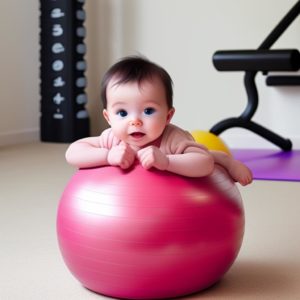Bouncing Back: Advantages of Birthing Ball Exercises in Postpartum Recovery
Nothing is more fulfilling or gratifying than giving birth to a beautiful new baby. During pregnancy, new parents spend much of their time preparing for the newest addition to the family and ensuring their homes are ready for the big day. Whether you are pregnant or planning to become pregnant in the future, it is important to prepare for your own homecoming – especially the challenges that come with postpartum recovery.
The experienced postpartum doulas at Happy Family After recommend purchasing a quality birthing ball for postpartum exercise and recovery. This one simple tool offers incredible benefits both during labor and after birth, and there are even clever ways to use a birth ball to soothe your baby back to sleep!
Understanding the Physical Challenges of Postpartum Recovery
No two postpartum recovery experiences are the same. In fact, the symptoms you experience with your second or third birth may be drastically different from your first. Most women will experience some sort of pain and tenderness, uterine contractions, and fatigue after childbirth.
Perineal Pain
The perineal area is the pelvic floor and the various structures associated with it. Giving birth is strenuous, and it stretches your pelvic muscles and tissues to their limits. You may notice some swelling, tenderness, and pain that gradually improves over the course of a week or two. If you experienced any tearing during delivery to your perinum, you may experience some increased pain and tenderness.
Back Pain
Back pain is quite common among new mothers. Some experience the pain associated with labor in their backs, and it can linger after childbirth. For others, back pain is the result of the newly shifted center of gravity or misalignment in the spine, and it gradually improves after birth.
Tenderness at the Incision Site
Parents who give birth via C-section may experience a different sort of pain and tenderness that occurs in the abdominal muscles and at the incision site. Most women agree that the pain improves significantly after the removal of the sutures or staples.
Ongoing Uterine Contractions
Uterine contractions do not abruptly end after delivering the baby and the placenta. During pregnancy, your uterus expands enough to comfortably hold a full-term baby, and it will eventually shrink back down to about the size of a fist. Uterine contractions aid in expelling any remaining blood or fluid after delivery, and they also play a role in helping the muscle return to its previous size.
Fatigue
Fatigue is by far the most common physical symptom parents experience after childbirth. This fatigue is caused by the energy needed to deliver a baby, hormonal changes that occur during pregnancy, childbirth, and immediately after childbirth, and an overall lack of sleep.
Advantages of Using a Birthing Ball for Postpartum Recovery
A birthing ball (also known as a yoga ball or exercise ball) is a phenomenal postpartum tool. Not only is it invaluable during labor for easing the pain and tension associated with contractions, but it can also be used after delivery for many important purposes, including postpartum exercises. Some of the biggest benefits associated with using a birthing ball for postpartum care include the following:
- Improving Posture and Spinal Alignment: Carrying a baby for nine months can have a significant impact on your posture and your spine. Gently bouncing on a birth ball while focusing on aligning your back, shoulders, and hips can help you realign your spine and improve your posture.
- Developing Core Strength and Stability: A birthing ball can also help you tighten and tone the muscles in your core after delivering your baby. A strong and stable core is important for a strong, healthy mom.
- Boosting Circulation and Lymphatic Drainage: Gentle movement is vital for your circulatory system, and it can even help with fluid retention by promoting lymphatic drainage.
- Alleviating Perineal Pain: Perineal pain can make it difficult to exercise comfortably, and it’s important to take it easy for several days after birth if you had an episiotomy or C-section. Birthing balls can improve your comfort by alleviating the pressure on this tender area.
- Healing the Pelvic Floor: Finally, birthing ball exercises can help realign the pelvis and strengthen the pelvic floor muscles. These exercises are important for long-term sexual and urinary health.
Benefits of Birthing Balls for Baby
Birthing balls are excellent companions before, during, and after birth, but you can also use them long after your baby arrives. Many new mothers find that holding their newborns while gently bouncing on the ball is soothing for both mom and baby. For baby, it mimics the gentle rocking they felt in the womb as you moved, and for you, the repetitive motion can be quite soothing.
New parents experiencing perineal pain may opt to feed their infants while sitting on the birthing ball. This is because the ball places less pressure on that sensitive area and alleviates pain, making it easier to enjoy the feeding and bond.
Safety First! Postpartum Exercise the Right Way
Like anything else, it is important to make sure that you are conducting your postpartum exercise with your birth ball safely. Always use your ball on a carpeted floor, or if your home does not have carpeting, purchase a non-slip mat for stability. Never use your ball while in socks; always wear non-slip shoes or slippers or opt for bare feet, instead. If you feel yourself growing fatigued while feeding your baby on the ball, move your baby back to the crib or bassinet for safety.
No two women have the same postpartum experience, so no two exercise routines will look the same. For the first few days after birth, aim for about 15 minutes of gentle bouncing once or twice per day. During this time, focus on your posture and alignment, and try to keep your core muscles tight. As you continue to heal, you can gradually increase the intensity.
While sitting on the ball may be the best option for brand new mothers in the first few days after birth, there are countless other ways to use it. For example, when you want to tone your abdominal muscles later down the road, you can lie on your back with your legs over the ball for some highly effective crunches. While in this position, you can gently lift your hips off the floor, hold for two seconds, and repeat 10 to 15 times for two to three sets.
Consulting a Postpartum Doula about Birthing Ball Exercises after Birth
It is important to consult a trained professional before starting any new exercise plan during or immediately after pregnancy, and a postpartum doula is an excellent choice. These professionals can help you choose exercises based on your unique childbirth experience and postpartum symptoms, and they can help you gradually increase the duration and intensity of that exercise until you reach your goals.
Happy Family After’s postpartum doulas are trained and experienced to help you through the challenges you face after giving birth. We are committed to accommodating your wants and needs so that you can be the parent you want to be. Whether you need support during the day or even overnight, Happy Family After provides the postpartum and newborn care services that matter most.
Learn more about Happy Family After’s postpartum doula services designed to support your whole health and your whole family – physically and emotionally – and all on your terms.

